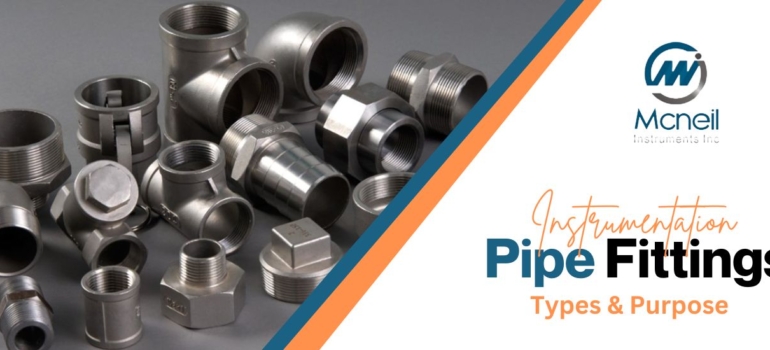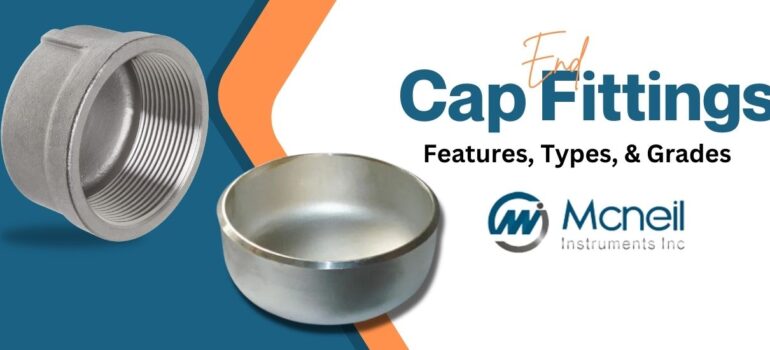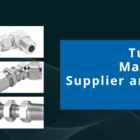Pipe Fittings Manufacturer, Supplier and Exporter in Canada
Mcneil Instrument is a leading Pipe Fittings Manufacturer, Supplier and Exporter in Canada. Pipe fittings are an essential part of piping systems and other machines that involve various types of pipes. Hence, we bring to you an extensive range of quality pipe fittings that will ensure the utmost durability and secure connection for your piping systems. Our Product line of Pipe Fittings include: Coupling Pipe Fitting, Plug Union, Cap Pipe Fitting, Female Branch Tee, Female Elbow, Male Run Tee, Female Run Tee, Buttweld Pipe Fittings
What Are Pipe Fittings?
Pipe fittings are used to connect, redirect, and control the flow of fluids and gases within piping systems. They come in various shapes and sizes, including elbows, tees, reducers, and couplings. Each type of fitting serves a specific purpose, and the material used can impact its performance and suitability for particular applications.
Comprehensive Product Portfolio
Mcneil Instruments Inc. offers an expansive catalog of precision-engineered products designed to meet various pipe fitting standards and dimensions:
| No. | Product Name | Size | Material | Additional Info |
| 1 | Coupling Pipe Fitting | 1/8″ to 4″ | Stainless Steel (304, 316, 316L, 321, 347, etc.), Carbon Steel, Alloy Steel, Copper-Nickel | End Connections: Threaded, Welded, etc. |
| 2 | Plug Union | 1/8″ to 4″ | Stainless Steel, Alloy Steel, Carbon Steel, Copper-Nickel | Pressure Ratings: Class 2000, 3000, 6000, 9000 |
| 3 | Cap Pipe Fitting | 1/8″ to 4″ | Stainless Steel, Carbon Steel, Alloy Steel | Standard: ASTM A182, ASTM A403, ASME B16.9, etc. |
| 4 | Female Branch Tee | 1/8″ to 4″ | Stainless Steel, Carbon Steel, Alloy Steel | End Connections: Threaded (NPT/BSP), Welding |
| 5 | Female Elbow | 1/8″ to 4″ | Stainless Steel, Alloy Steel, Copper-Nickel, Carbon Steel | Surface Finish: Plain, Pickled, Sand Blasted |
| 6 | Male Run Tee | 1/8″ to 4″ | Stainless Steel (304, 316, 316L, 321, 347, etc.), Duplex Steel, Super Duplex Steel, Carbon Steel, Alloy Steel | Pressure Rating: Class 2000, 3000, 6000, 9000 |
| 7 | Female Run Tee | 1/8″ to 4″ | Stainless Steel, Duplex Steel, Super Duplex Steel, Carbon Steel, Copper-Nickel | End Connection Type: Threaded (NPT/BSP), Welding |
| 8 | Buttweld Pipe Fittings | 1/8″ to 4″ | Stainless Steel, Carbon Steel, Alloy Steel, Copper-Nickel | Standard: ASME B16.9, ASME B16.11, MSS SP-79, etc. |
Pipe Fitting Material Options
When choosing pipe fitting materials, it’s essential to consider the specific requirements of your application. Here’s a breakdown of various options:
- Stainless Steel: Best for environments requiring high corrosion resistance and strength.
- Carbon Steel: Suitable for high-pressure and high-temperature applications at a lower cost.
- Brass: Ideal for residential plumbing with good machinability and aesthetic appeal.
- PVC: Affordable and versatile, perfect for water supply and drainage.
- CPVC: Handles higher temperatures, making it suitable for hot water systems.
- PEX: Flexible and durable, great for residential plumbing and heating systems.
Quality Assurance & Certifications
Mcneil Instruments Inc. continues to lead as one of the best ppie fittings suppliers in Canada, with a strong emphasis on quality assurance. The company meets international pipe fitting certifications such as:
● Indian Plumbing Association (IPA) Certified Plumbing Professional: This certification, provided by IPA, ensures proficiency in modern plumbing systems, installation, and maintenance according to Indian standards and regulations.
● CIPET (Central Institute of Petrochemicals Engineering and Technology) Piping Design and Engineering Certification: CIPET offers specialized certification courses on piping design and engineering, focused on industries like petrochemicals, refineries, and process plants.
● Bureau of Indian Standards (BIS) Certified Pipe Fitter: BIS offers certification programs that train individuals in pipe fitting skills, emphasizing quality standards and safety regulations specific to the Indian industry.
● Industrial Training Institutes (ITI) Plumber Trade Certification: This government-recognized certification equips individuals with practical skills in plumbing and pipefitting through a formal training program, focusing on hands-on experience and compliance with Indian codes.
Mcneil Instruments: Global Exporter of Approved Pipe Fittings – Region-Wise Coverage
I. Middle East: Comprehensive Supply of Approved Fittings
- Region: UAE, Oman, Kuwait, Qatar, Bahrain, Saudi Arabia
- Industries Served: Oil & Gas, Petrochemicals, Construction, Marine
- Commitment: McNeil Instruments is a leading supplier of pipe fittings in the Middle East. Our products adhere to stringent regional and international standards, crucial for high-demand sectors.
- Partnerships: We are a trusted partner for government projects, refineries, and industrial infrastructure.
- Specific Country Focus:
- UAE: Supplying pipe fittings for oil refineries, offshore drilling operations, and diverse energy projects.
- Oman: Catering to Petroleum Development Oman (PDO), oil exploration initiatives, and infrastructure development.
- Kuwait: Meeting the specific requirements of Kuwait National Petroleum Company (KNPC), Kuwait Oil Company (KOC), and other heavy industrial applications.
- Qatar: Supporting major players like Qatar Gas, LNG processing facilities, and petrochemical plants with reliable pipe fitting solutions.
- Bahrain: Delivering high-quality pipe fittings for marine, energy, and manufacturing sectors.
- Saudi Arabia: Ensuring compliance with Saudi Aramco standards for pipeline projects, refineries, and petrochemical industries.
II. North America: High-Grade Fittings for Canadian Industries
- Region: Canada
- Industries Served: Mining, Energy, Construction, Water Treatment
- Product Standards: McNeil Instruments provides high-grade, industry-certified pipe fittings tailored for Canadian industries. Our pressure-resistant and corrosion-proof fittings comply with Canadian regulations.
- Application Focus: Ensuring safe and efficient operations in oil sands, natural gas extraction, and various industrial projects across Canada.
Conclusion
In summary, Mcneil Instruments stands as a premier manufacturer, supplier, and exporter of high-quality pipe fittings in Canada, with a robust global presence. Our extensive product portfolio, encompassing a wide range of materials, sizes, and specifications, ensures that we can meet the diverse needs of various industries. From stainless steel fittings designed for high corrosion resistance to carbon steel fittings suitable for high-pressure applications, we provide solutions that prioritize durability and reliability.
Our commitment to quality is underscored by our adherence to international standards and certifications, including those from the Indian Plumbing Association (IPA), CIPET, Bureau of Indian Standards (BIS), and Industrial Training Institutes (ITI). This dedication to excellence extends to our global operations, where we serve critical sectors in the Middle East and North America, ensuring that our products meet the stringent requirements of these demanding markets.
Whether it’s supporting the oil and gas industry in the UAE or providing high-grade fittings for mining operations in Canada, Mcneil Instruments consistently delivers exceptional products and services. We are a trusted partner for projects of all scales, committed to providing reliable, durable, and certified pipe fitting solutions that drive efficiency and safety.
For all your pipe fitting needs, choose Mcneil Instruments, your dependable partner for quality and reliability.

























